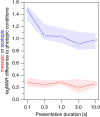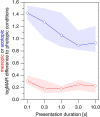The "speed" of acuity in scotopic vs. photopic vision
- PMID: 32803325
- PMCID: PMC7677280
- DOI: 10.1007/s00417-020-04867-6
The "speed" of acuity in scotopic vs. photopic vision
Abstract
Purpose: The effect of duration of optotype presentation on visual acuity measures has been extensively studied under photopic conditions. However, systematic data on duration dependence of acuity values under mesopic and scotopic conditions is scarce, despite being highly relevant for many visual tasks including night driving, and for clinical diagnostic applications. The present study aims to address this void.
Methods: We measured Landolt C acuity under photopic (90 cd/m2), mesopic (0.7 cd/m2), and scotopic (0.009 cd/m2) conditions for several optotype presentation durations ranging from 0.1 to 10 s using the Freiburg Acuity and Contrast Test. Two age groups were tested (young, 18-29 years, and older, 61-74 years).
Results: As expected, under all luminance conditions, better acuity values were found for longer presentation durations. Photopic acuity in young participants decreased by about 0.25 log units from 0.1 to 10 s; mesopic vision mimicked the photopic visual behavior. Scotopic acuities depended more strongly on presentation duration (difference > 0.78 log units) than photopic values. There was no consistent pattern of correlation between luminance conditions across participants. We found a qualitative similarity between younger and older participants, despite higher variability among the latter and differences in absolute acuity: Photopic acuity difference (0.1 vs. 10 s) for the older participants was 0.19 log units, and scotopic difference was > 0.62 log units.
Conclusion: Scotopic acuity is more susceptible to changes in stimulus duration than photopic vision, with considerable interindividual variability. The latter may reflect differences in aging and sub-clinical pathophysiological processes and might have consequences for visual performance during nocturnal activities such as driving at night. Acuity testing with briefly presented scotopic stimuli might increase the usefulness of acuity assessment for tracking of the health state of the visual system.
Keywords: Mesopic vision; Photopic vision; Scotopic vision; Temporal factors; Visual acuity.
Conflict of interest statement
The authors declare that they have no conflict of interest.
Figures






References
-
- Graham CH, Cook C. Visual acuity as a function of intensity and exposure-time. Am J Psychol. 1937;49:654–661. doi: 10.2307/1416390. - DOI
-
- Monjé M, Schober H. Vergleichende Untersuchungen an Sehproben für die Fernvisusbestimmungen. Klin Monatsbl Augenheilkd. 1950;117:561–570. - PubMed
-
- Zanen J, Klaassen-Nenquin E. Acuité visuelle en fonction du temps d’exposition. Bull Soc Belge Ophtalmol. 1957;114:574–581. - PubMed
MeSH terms
LinkOut - more resources
Full Text Sources
Research Materials

